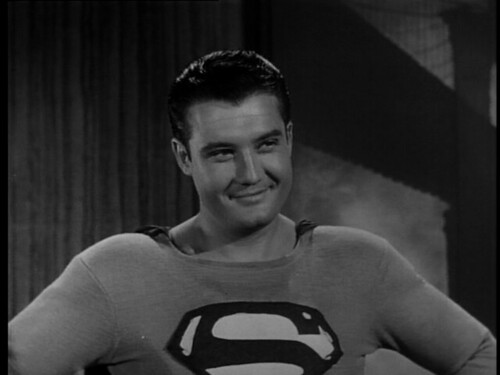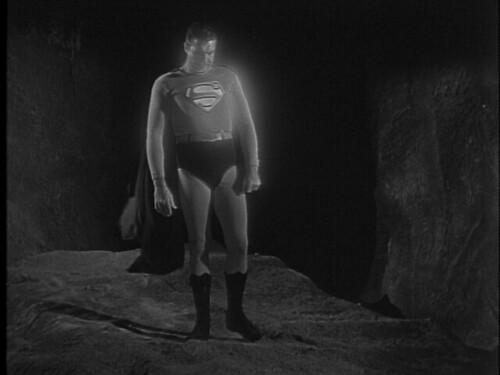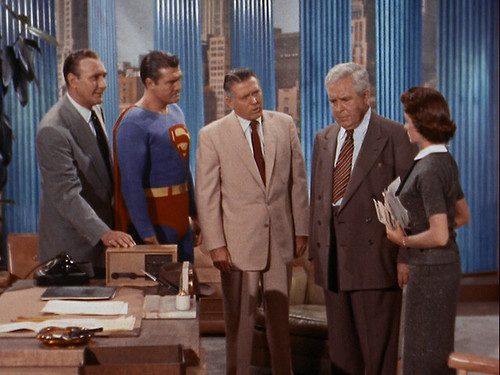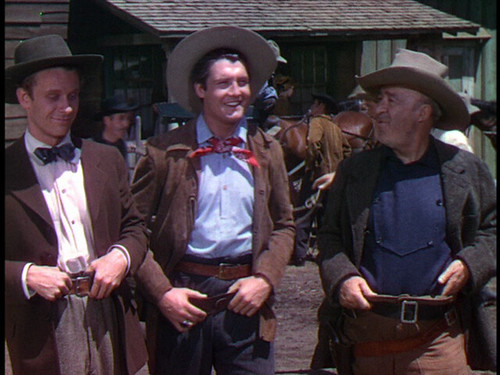
George Reeves would have turned 100 today, January 5, 2014. He’s most famous, of course, for playing Superman on the TV series, “Adventures of Superman,” which ran original shows from 1952 to 1958, for a total of 104 half-hour episodes, half of which were in black-and-white and half of which were filmed in color. These shows ran in syndication for decades afterward and are showing somewhere in the world right now as I write this. I watched the show on TV as a child and was a devoted fan. When I learned to read, I began reading Superman comics also, but my first exposure to the character was via the TV show. Reeves died on June 16, 1959, after the show had finished its sixth season. My siblings and I had begun watching the show well before then. I don’t remember hearing reports of Reeves’ death at the time, which came not long before my sixth birthday. At some point a neighbor girl from the apartment next door told me that the actor who played Superman thought he was really Superman and died when he jumped off a building thinking he could fly. I’m not sure when I learned the official story—that he’d gone upstairs during a party at his home and shot himself in the head. In recent decades, that account has been disputed by investigators who believe he was murdered. I read a book about it once that argued the latter point, but I have to confess I need more information before I can find this theory convincing.

In any event, I watched Superman episodes on TV for years, finally getting to watch the color episodes in color for the first time in 1978 when I finally bought a color TV set. At some point in the 1980s, the local TV station that had been running “Adventures of Superman” stopped doing so and I didn’t see any episodes for about 20 years or more until I picked up a DVD box set of the color episodes from the third and fourth seasons in 2009. I picked up two more box sets, covering the first and second seasons, in 2013, so I now had all 78 episodes from the first four seasons of the series. This past Thursday, I happened to look up George Reeves on IMDB and realized that today would be his centennial, so I started watching episodes again, totaling 28 since Thursday evening, mostly from the first two seasons.

I’ve often heard that the first season had a completely different tone from the rest of the series. It was more of a crime show than a superhero science fiction show, with sharp bursts of violence. According to some observers, it was closer to film noir than anything else. It had a different actress playing Lois Lane and the conception of the character was different—more proactive, independent and something of a proto-feminist. Season Two, on the other hand, was designed to be more like the comic book and brought back the original actress who’d played Lois Lane in the movie serials from 1948 and 1950. As the seasons progressed, the series became more and more child-friendly with less and less violence.

Growing up, I’d never seen a lot of episodes from Season One, nor were these episodes rerun very frequently in later decades. Until I picked up the Season One box set a couple of months ago and started watching the episodes, it’s a safe bet that I hadn’t seen any episodes from Season One in close to 50 years. So I watched twelve of them in preparation for this piece and then 13 from Season Two. And three of the later color episodes before I called a halt, although I’d seen more from the color box set in earlier viewings back in 2011.

Clark Kent (George Reeves) and Lois Lane (Phyllis Coates)
Yes, Season One is grittier and more violent than the rest of the series. Superman is much more aggressive than he is in later seasons. He doesn’t pull his punches when he pummels the bad guys and tosses them around. A “real” Superman punch like that would have killed them. He’s also pretty cruel towards them, as in the scene at the end of “The Stolen Costume” when he takes a married pair of criminals (Dan Seymour and Veda Ann Borg) and flies them to a remote snowy mountain top and leaves them there for the crime of knowing that he’s also Clark Kent. He promises to bring them food, water and material for shelter, but after he flies away, they opt to try to climb down the mountain by themselves and fall to their deaths. (How convenient.)

Dan Seymour, Veda Ann Borg, George Reeves in “The Stolen Costume”

Superman slugs a crook in “The Riddle of the Chinese Jade,” Season One
As played by Phyllis Coates in the first season, the short-haired Lois Lane is indeed a thorough professional and no-nonsense all the way. There’s never any hint of a romance between her and Superman. She doesn’t ask for help and insists on doing things her own way. She puts up a fight when she needs to. She’s astonishingly antagonistic to her colleague, Clark Kent (Reeves). She’s less antagonistic to the hapless Jimmy Olsen (Jack Larson), cub reporter, and her boss, Perry White (John Hamilton), but is never particularly kind to them either.

Inspector Henderson (Robert Shayne) and Lois Lane (Phyllis Coates)
Of the episodes I watched from Season One, most of the stories were standard-issue crime stories, most of which could have been resolved without Superman’s help. There’s often a minor caper involved. There is a wide variety of settings, with the characters frequently traveling to other countries or other parts of the U.S., so these stories didn’t always rely on the same cramped over-used urban sets we see in subsequent seasons. Just in the episodes I saw, characters went to Germany, Haiti, Peru, a Northwest lumber camp, Hollywood, Chinatown and the Louisiana bayou. (The episodes set in Haiti, Peru, and Chinatown deserve some props for casting minority actors in respectful, dignified roles completely devoid of stereotype.)

Milton Wood as a Haitian police official who confers with Clark Kent in “Drums of Death”
Season Two brought back Noel Neill, who’d played Lois in the two Columbia Pictures movie serials, “Superman” (1948) and “Atom Man vs. Superman” (1950) and the whole dynamic of the relationship of the central characters changed. Neill’s Lois is warm. She’s a little less competent than Coates’ Lois and not quite as self-reliant. She’s clearly needier and admires Superman on a personal level in ways that Coates’ Lois couldn’t. She occasionally bickers or competes with Clark, but it’s clear that they’re very close and affectionate with each other. Clark smiles more here.

Clark Kent (George Reeves) and Lois Lane (Noel Neill)

The stories are, to me, much better in Season Two. They’re more like the comic book and show a little more imagination than the feeble caper stories we got in Season One. Reeves gets to spread his acting wings a bit more and step out of the box his characters are usually confined to. In “Superman in Exile,” there’s a hard science element as he enters a top-secret experimental nuclear installation and has to rearrange some rods in a reactor to stop a meltdown. He gets dosed with so much radiation as a result that he has to remove himself from humanity until he can find a way to clean himself up. He even lectures the scientists for allowing the experiment to get out of control in a rare display of messaging in the series as he hints at the dangers of nuclear power. As he suffers loneliness from the isolation, and a feeling of helplessness, we get a rare glimpse of Superman’s emotional state.



“Panic in the Sky,” often cited as the best episode in the entire series, deals with an asteroid on a collision course with Earth and the realization, after Superman has halted its slide into Earth’s gravity, that it still poses a massive threat to Earth because of its gravitational pull. All this is exacerbated by Superman’s amnesiac state, induced by the explosion caused by his first collision with the asteroid. (He even almost gives away his secret identity to Jimmy Olsen.) Clark’s confusion around Lois, Jimmy and Perry White is pretty amusing to watch. When they ask him to get in touch with Superman, he asks if they have any pictures of him. (This episode marks the only time they see him as Clark without his glasses. He’s in his pajamas, though, which has the same effect of “blurring” his resemblance to Superman. In a later scene, he still has his glasses on while wearing his Superman costume, further dissolving the lines between the two identities.)




In “The Face and the Voice,” Reeves plays a second role, that of “Boulder,” a small-time crook recruited to become a plastic surgery-enhanced double of Superman, thanks to his resemblance to the superhero. Here Reeves gets to play an uneducated lowlife who has to listen to a recording of Superman’s voice and learn how to imitate it well enough to fool store-owners into giving him their money when he strides into their stores and asks for it. When he’s not “in character,” Boulder reverts back to his normal way of talking (which sounds somewhat like early Jack Palance) even when he’s in full Superman getup. I would argue that Reeves probably had the most fun making this episode. It’s certainly fun for us to see him do something completely different—and genuinely funny.




By the time of the color episodes, the makers of the series, Reeves included, had decided to go family-friendly all the way, softening the action and violence considerably and beefing up the comic elements. Comic relief Jimmy Olsen gets episodes where he dominates the action, such as “Olsen’s Millions,” where he becomes a millionaire for a day. Perry White gets an entire episode where he confronts “Great Caesar’s Ghost,” after invoking him so often in the series up to that point. There’s even a romantic episode where Lois, pressed into duty as a columnist providing advice to the lovelorn, dreams about “The Wedding of Superman.” It’s a rare moment indeed where we see Superman express his feelings for Lois. A low point in the series comes in the first color episode, “Through the Time Barrier,” when the characters all go back in time and live as cavemen. (Paging the Flintstones!)


The color in these episodes looks great. I just wish they’d done more hard sci-fi episodes once they started shooting in color. Imagine what “Panic in the Sky” and “Superman in Exile” would have looked like in color.



From the ones I watched in the brief lead-up to this piece, I tend to prefer the Season Two episodes. For one thing, Lois is played by Noel Neill, whom I’ve always associated with the role and with whom I’ve always felt more comfortable. The series struck a nice balance between comic book fantasy adventure, with the appropriate superhero thrills, and the need to be child-friendly. Season One is more interesting in a lot of ways, but I didn’t quite warm up to these episodes. Something was missing for me. They were all over the place. I preferred the cohesion of the later seasons and the refined family dynamic of the central cast. I also found Superman’s roughness in the first season off-putting. Superman’s supposed to be kind and gentle. Yes, I found it satisfying when he slugged a bad guy, giving them what they deserved, but Superman’s not supposed to be Dirty Harry. At the same time, he’s not supposed to be Santa Claus either, a characterization toward which he tended to veer in some of the later episodes.
Reeves had an active film career in the 12 years prior to filming “Adventures of Superman,” but he did little that would remain as memorable as Superman. He had parts of varying lengths in major studio films (GONE WITH THE WIND, THE STRAWBERRY BLONDE, LYDIA) and was Claudette Colbert’s love interest in the war drama, SO PROUDLY WE HAIL (1943). He has a credit as “Wounded Messenger” in Cecil B. DeMille’s epic about another legendary strongman, SAMSON AND DELILAH (1949), and lead roles in a few low-budget productions. He starred as a logger alongside Ralph Byrd (Dick Tracy) in THUNDER IN THE PINES (1948) and the two were also jungle explorers together in JUNGLE GODDESS (1948). He plays an ambiguous character on an expedition with the title character in JUNGLE JIM (1948), which starred Tarzan himself, Johnny Weissmuller. He plays the title character in the serial, THE ADVENTURES OF SIR GALAHAD (1949), the only time he got to play an iconic hero as a central character before “Adventures of Superman.” (He also played Buffalo Bill Cody in a Technicolor Warner Bros. short, “Pony Express Days,” 1940, included as an extra on one of the box sets.) In the 1950s he managed to attract the attention of major directors Fritz Lang, who cast him in RANCHO NOTORIOUS and THE BLUE GARDENIA, and Fred Zinnemann, who cast him in FROM HERE TO ETERNITY, the Best Picture winner of 1953. The story is that preview audiences went nuts at seeing “Superman” onscreen in ETERNITY and the producers opted to cut his part down to lessen the distraction. He only had one other role in a major Hollywood feature after that (FOREVER FEMALE, 1953).

George Reeves (center) as Buffalo Bill in “Pony Express Days,” flanked by David Bruce (left) and J. Farrell McDonald
Reeves’ claim to fame and his single greatest achievement remains, of course, Superman. His portrayal of the character remains remarkably effective 60 years later. As children, we believed he was Superman and as an adult, I marvel at how seriously he took the character and the extent of his obligation to the audience. He cared deeply about the character and about the show and it’s obvious in every one of his 104 weekly performances. Despite all the incarnations of the character in the decades since, Reeves’ Superman continues to dominate discussion of all filmed versions of the character, at least when Baby Boomers are involved in the discussion. Christopher Reeve, who played Superman in the 1978 big-budget movie version and three sequels, comes close in the popular imagination, but he’s never been able to dislodge George Reeves from the top spot. Nor, I daresay, will any actor who’s played him since. Of course, this may all change as younger Superman fans grow up without ever being exposed to the original series. It’s up to their Baby Boomer parents to insist they sit down and watch.


GREAT remembrance! Makes me want to watch the show now! Also “Hollywoodland” is a pretty good film about George Reeve’s final days, at least when it centers around Reeve (a wonderful, Oscar-worthy Ben Affleck), and not he investigation with Adrien Brody (ugh)..
Miss you pal. happy healthy New year to you and may we meet up somewhere some how!!
-Mozenator
I think C Reeves makes a better Superman, but G Reeves a better Clark Kent. I recently saw part of Superman Returns, and Brandon Rouff stinks as Superman and even as Clark Kent. None of the ladies do a good Lois. Margot Kidder did the best of the modern lot. I mean Alicia Beck (from the Living Color skit Handiman) did a better Lois than some of the modern gals.
Reeves would need a goatee to look like Buffalo Bill. In that pic he looks like Superman in a cowboy hat.
To be fair, he plays a very young William Cody in that film and doesn’t get the name “Buffalo Bill” bestowed on him until the very end in the last shot of the film, from which I took that screen grab. McDonald is calling him “Buffalo Bill” for the first time there, hence the smile on Reeves’ face.
Reeves had a major role in SO PROUDLY WE HAIL, and not a minor one, as the writer claims. The film was a well-received “A” picture that appeared to be an important step on Reeves’s climb to stardom. But WWII came along, and like a lot of other young actors, Reeves left for the service. When he returned, death had taken a studio patron, and Reeves fell back into supporting parts and ledes in B movies, and even a serial. But for a brief interlude, he had seemed about to break through.
Thanks, Mr. Hogan, I appreciate the correction. I’ve seen SO PROUDLY WE HAIL since doing this piece and had forgotten I’d mentioned it in this context. I just went back and reworded the line.
Nice rework of your original thought. Your thoughts re seasons 1 and 2 of Ad of S are excellent, thanks. I prefer season 1 but I agree with you that season 2 has more continuity, and better interpersonal relationships among the principal characters. If only George had lived long enough to discover how much he means to so many.
Try my Facebook page on George Reeves as Superman! … https://www.facebook.com/groups/449814022562254
I LOVED THE MAN OF STEEL GROWING UP. I WAS 6 YEARS OLD WHEN MY COUSIN TOLD ME HE DIED. VERY UPSET. I HAVE ALL THE EPISODES ON DVD AND THEY ARE ONE OF MY PRIZED POSSESIONS. LONG LIVE SUPERMAN.